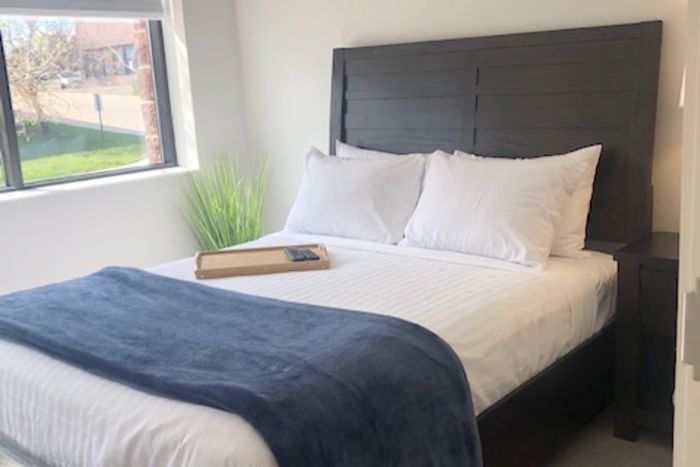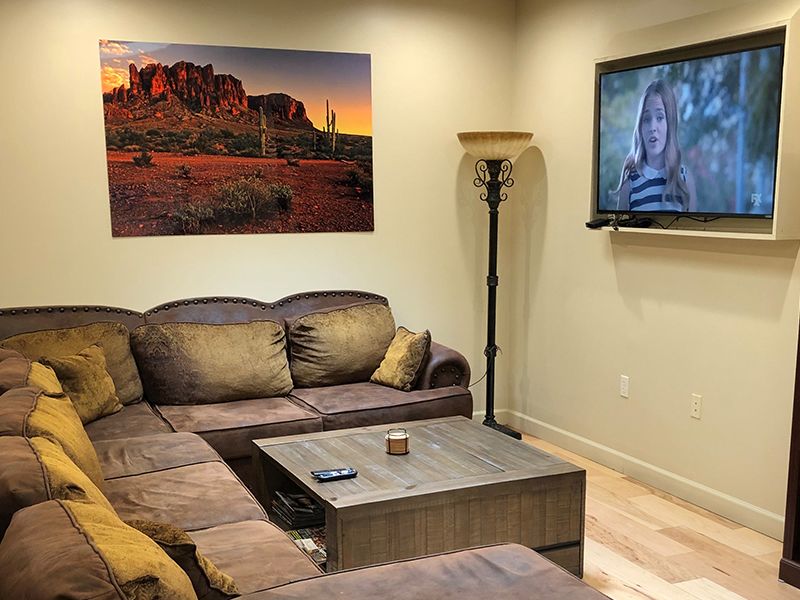The transition from an addiction treatment program to daily life is a fundamental step in the recovery journey. Many people can feel overwhelmed and isolated during this time. These feelings are normal—you’re navigating new territory and adjusting to a new lifestyle.
To make the adjustment period more manageable, some luxury treatment centers will set you up with a support system as part of their continuing care program. Another way to bolster your support network is with a sober coach, also known as a recovery coach. Many sober coaches are affiliated with rehab centers or hospitals. However, some work with free-standing organizations, or as private practitioners.
Sober coaches can help you feel less isolated, hold you accountable and offer advice and guidance to ensure sustainable recovery as you return to life outside treatment.
A sober coach may be a good option if you want a more hands-on relationship with a non-clinical professional who can guide you through this particularly sensitive stage. Keep in mind that a sober coach is not a replacement for other parts of your continuing care program. Rather, they supplement aspects of continuing care and offer support that some people may need for long-term recovery.
Since sober coaching is a relatively new position in addiction treatment, we explore how their role is defined and ways in which they can support your recovery.
What Is a Sober Coach?
The recovery journey doesn’t stop when a rehab program ends. In more recent years, we’ve seen a rise in new peer-based recovery support services1 that has stemmed from the need to provide people with extra support as they transition from a formal treatment program into their natural environment. A growing number of peer-based recovery support services and new roles have been designed to assist people during that transition period and help them maintain long-term sobriety. One of those roles is a sober coach.
Sober coaches can have many different titles, including recovery coach, recovery manager, recovery mentor, recovery guide and more. Their role remains the same: to provide someone with “non-clinical assistance to support long-term recovery from substance use disorders.”2
Unlike clinical professionals, sober coaches don’t need to have formally acquired credentials. Instead, sober coaches draw on experiential knowledge and expertise3 to help clients achieve and maintain lasting sobriety. Their knowledge generally comes from their own addiction recovery experiences or from helping others recover.
According to the Substance Abuse and Mental Health Services Administration (SAMHSA), a sober coach offers supportive assistance, rather than directives.4 They can help with a number of recovery-related issues:
- Setting recovery goals
- Developing recovery action plans
- Finding new peers
- Improving job skills
- Exploring new hobbies and things to do in your spare time
- Finding sober housing

Generally, a sober or recovery coach offers the four following types of support:
Emotional Support
Emotional support includes anything that addresses your emotional concerns. This could range from inspirational coaching to empathetic listening and encouragement.
Informational Support
Sober coaches can connect you with resources and information that benefit your recovery, like learning a new life skill or developing new coping strategies for dealing with challenges.
Instrumental Support
This includes assistance with concrete, practical tasks like finding housing and employment.
Affiliational Support
A sober coach can help you connect with others who can bolster your recovery journey. This might take place through events,activities, or online or in-person communities.
The Difference Between Sober Coaches and Sober Companions
There are several roles that involve helping people maintain long-term recovery beyond inpatient rehab. It’s important to clarify the distinction between them, to ensure you look for the right type of guidance.
A common misunderstanding is that sober coaches are like sober companions. However, their roles are markedly distinct.
Sober Coaches (or Recovery Coaches)
A sober coach is a hired, non-clinical professional who supports your long-term recovery from substance use disorders. Most have been through recovery themselves and are trained on how to help others through the journey. Sessions with your recovery coach occur on a regular basis and are held via phone, online or even onsite at your treatment center.
Sober Companions
A sober companion is generally more involved in your daily life than a sober coach. They will accompany you throughout your day as necessary, to ensure you have the support and accountability you may need to prevent a relapse.

Who Are Sober Coaches a Good Fit For?
Sober coaches offer support through various stages of the recovery journey.5
A sober coach could be a good fit for you if you don’t have a strong support network, live in an environment with many triggers, or need additional help with daily life. Some people can benefit from having a sober coach in more than one stage of their recovery journey.
The Pre-Decision Stage
Before you make a decision to enter residential treatment, a sober coach can help you take this big step. They can ensure you feel less isolated through the process and assist with finding a rehab that suits your needs. Once you’ve found a program, they can guide you through the entry process.
During Treatment
A sober coach who supports you during a rehab program takes on a slightly different role. They are an advocate and will help you foster life skills for lasting sobriety. For example, Hope Rehab Center in Thailand has a treatment model that includes exposure therapy, wherein clients are taken on excursions to experience the outside world. Their on-site sober coach supports you during these encounters to help you handle real emotions that may come up during life after rehab.
Aftercare
A number of luxury addiction treatment centers across the globe offer sober coaching as part of their aftercare program. Oftentimes, sober coaches that work with rehab centers reflect the same level of care, support and privacy your addiction treatment program offers.
In Europe, both Villa Paradiso Rehab in Marbella, Spain and Tabula Rasa Retreat in Portugal have aftercare recovery coaches.
Australia has a number of treatment programs with sober coaches as part of their aftercare, including Noosa Confidential in Sunshine Coast and The Banyans in Brisbane.
The United States has plenty of options across the country. For example, Oceanside Malibu in California, JourneyPure in Tennessee, Blue Ridge Mountain in Georgia and The Sanctuary at Sedona in Arizona all offer recovery coaching as part of their aftercare programs.
It’s important to keep in mind that while sober coaches offer valuable support and life skills for sobriety, they should not replace the care you’ll receive from healthcare professionals and therapists during primary treatment and aftercare.
The Difference Between Sober Coaches and Other Addiction Treatment Professionals
Sober coaches are relatively new in addiction treatment and can perform many different roles in someone’s recovery,6 which sometimes leads to role ambiguity.
The public still holds some confusion about the responsibilities of sober coaches compared to other addiction treatment professionals. However, there are established differences as outlined in the Great Lakes Addiction Technology Transfer Center’s guidelines for ethical peer-based recovery support.7 It’s important to understand these distinctions to make sure you’re looking for the right professional for your needs.
Sober coaches are not healthcare professionals.
Unlike doctors, nurses, or psychiatrists, most recovery coaches don’t have medical degrees. Their role is never to diagnose you or provide you with medical advice or care.
Instead, a sober coach helps you remove potential roadblocks that might prevent you from seeing a medical professional. For example, they can help you find the right medical professional, or drive you to your appointment.
Sober coaches are not social workers or addiction counselors.
Unlike social workers and addiction counselors, sober coaches take on a more informal role and aren’t required to have a degree in social work or formal credentials in counseling.
Whereas addiction counselors are discouraged from self-disclosure, or using their personal experience to connect with clients, sober coaches are encouraged to share their personal experiences with you. They act as your confidant.
If you need professional help from a social worker or an addictions counselor, your sober coach will help you get in touch with them.
Sober coaches are not sponsors.
Unlike with sponsors, you and your sober coach don’t uphold each other’s sobriety. Some sober coaches haven’t struggled with addiction before, but are there to support you, especially during sensitive transition periods.
A relationship with a sober coach is more like that of a mentor and a mentee, or a personal trainer with their client.

How to Find the Right Sober Coach for You
Most sober coaches work in affiliation with recovery centers and hospitals. However, some work with free-standing organizations or as private practitioners.
Since sober coaches don’t need to have formally acquired credentials, it’s important to take extra precautions when searching for one, especially if you plan to look outside of your rehab program.
If you’re unsure where to start, you could ask recovery centers during an initial phone call if they have any referrals for reputable sober coaches. If you’re already seeing a therapist, you could ask if they have any recommendations for you.
How to Search for Rehab Center-Affiliated Sober Coaches
1. Check the addiction treatment center’s reputation and credibility.
Doing this as the first step gives you a good idea of the level of expertise a rehab center would expect from its employees and affiliates.
Reputation Check
Read through the rehab center’s online review. You can also ask around to see if they’re in good standing with other healthcare providers or treatment facilities.
Accreditation Check
In the U.S., there are two national organizations that accredit treatment providers. These include the Joint Commission and Commission on Accreditation of Rehabilitation Facilities (CARF). While rehabs might showcase accreditation logos on their website, you should check directly with the accrediting body.
2. Ask the addiction treatment center for sober coach options.
After you’ve found a reputable rehab center you trust, ask them for referrals of sober coaches. Usually, you would have gone through an initial phone call with an admissions specialist first. They’ll ask general background questions, including questions about your medical history, substance use history and family history.
Once they have a better understanding of your situation, they will give recommendations for different sober coaches. You can compare their backgrounds and even go through an initial phone call with them to find a sober coach that best matches your needs.
How to Search for a Private Sober Coach
If your addiction treatment program doesn’t offer sober coaching, you can hire a private sober coach to help you at any point in your recovery journey. Much like rehab centers, there are certain markers you should look out for to ensure you hire a credible, reputable sober coach who matches your needs.
1. Ask people you trust.
You can start your search by asking people you trust if they have any recommendations for sober coaches. This could be your therapist, psychiatrist or even your doctor.
2. Check the sober coach’s reputation, accreditations and affiliations.
Important to note: there’s no professional, independent governing body that offers accreditations to sober coaches.
Many private sober coaches have a website. It’s recommended to look through them and use these indicators to check whether the sober coach is reputable and has the level of expertise you’re looking for:
- Online reviews—These give you a general idea of a private sober coach’s reputation.
- Feedback—Reach out to people who have used that sober coach’s service and ask for their feedback.
- Relevant qualifications—Some credentials to look out for include psychiatric, medical, or social work accreditations or degrees. Keep in mind that if a sober coach doesn’t have the degrees listed above, it doesn’t necessarily mean they’re not qualified.
- Work experience—Check a sober coach’s work background to see how many years they’ve been a practicing coach and if they have experience with others in similar situations as yours.
- Affiliation with treatment centers or hospitals—Check the qualifications of the centers they’ve partnered with to give yourself an idea of their credibility and professionalism.
Sober Coaches Offer the Extra Support Many People Need for Long-Term Recovery
Adjusting to life after rehab can feel like a difficult prospect. As you journey to create a healthy, substance-free lifestyle, there are resources and tools you can turn to that help make the adjustment easier.
For many people, sober coaches are a pillar to lean on and offer invaluable support they need for long-term recovery. The relationship is often grounded in trust, health and wellness, which is why finding the right person is so important.
Many established rehabs either have referrals for sober coaches or have sober coaching as part of their program. To get your search started, browse our collection of luxury rehabs that offer sober coaching.
Frequently Asked Questions About Sober Coaches
What is a sober coach?
A sober coach, also known as a recovery coach, provides supportive assistance to people in long-term recovery. They supplement other aspects of continuing care and can help with setting recovery goals, developing action plans, finding new peers, improving job skills, exploring new hobbies, and finding sober housing.
What’s the difference between sober coaches and sober companions?
A sober coach is a non-clinical professional who supports long-term addiction recovery. They provide regular assistance through phone, online, or in-person sessions. A sober companion, on the other hand, is more involved in a client’s daily life, providing support and accountability to prevent relapse and accompanying them throughout the day as needed.
How can I find a sober coach?
To find a sober coach, follow these steps: 1. Check the reputation and credibility of the addiction treatment center you are associated with. 2. Ask the treatment center for referrals of sober coaches. Compare their backgrounds and have an initial phone call with them to find a match. 3. If your treatment program doesn’t offer sober coaching, you can hire a private sober coach. Ask trusted professionals like therapists or doctors for recommendations and check their reputation, qualifications, work experience, and affiliations with treatment centers or hospitals.



















